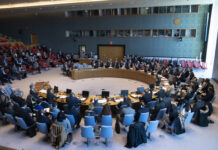Photo credit: DiasporaEngager (www.DiasporaEngager.com).
Iranian President Ebrahim Raisi died on May 19 while returning from a ceremony to inaugurate a hydropower project in a remote corner of northwestern Iran. Why would a head of state brave the hazardous conditions of unseasonal blizzards in a mountainous region to open a run-of-the-mill water and power project? Why not send his minister for energy to stand in for him? Why was the project so important as to even invite the head of state of neighboring Azerbaijan, which had only three months ago shut down its embassy in Tehran to protest a violent attack on its staff?
The answer: climate change.
As much as 97 percent of Iran suffers from a 30-year drought. Droughts are exacerbated by two major factors: a dramatic drop in precipitation and an evaporation driven by scorching temperatures. On average, Iran receives 250 millimeters of rain a year, which is close to one-third of the global average. Yet two-thirds of Iran’s average precipitation evaporates each year. Certain spatial and temporal variations in rainfall patterns leave much of the country vulnerable to drought.
True to these variations, Iran’s Caspian Sea basin is the wettest of all with rainfall as high as 1,600 millimeters per year. Yet climate-induced water scarcity and evaporation of moisture in other parts of the country are exacting a heavy toll on Iran’s already dwindling water resources. A case in point is the agriculture sector, which now guzzles 93 percent of national freshwater supplies. Scarcity of water has become the catalyst of climate-induced drought that Raisi was combatting with the opening of dam and hydropower projects.
No Iranian president had been more proactively responding to climate-induced scarcity in the country than Raisi. His “water diplomacy” was meant to elevate relations with neighboring states—such as Azerbaijan and Armenia, which share transboundary waterways—to a “special level.” The imperative to secure water resources put Iran on the side of Christian Armenia against Muslim Azerbaijan during their 30-year violent conflict over the Nagorno-Karabakh region. In response, Azerbaijan sought help from Israel and Turkey, which provided Baku with heavy artillery, rocket launchers, and attack drones, especially for the final push in September 2023 that left Azerbaijan in control of all of Nagorno-Karabakh.
Now that Azerbaijan controls Nagorno-Karabakh, Iran’s water diplomacy has spun to Baku. Supreme Leader Ayatollah Ali Khamenei sent his “personal emissary” to the inaugural ceremony of the hydropower plant on May 19 to meet with Azerbaijan’s President Ilham Aliyev. Khamenei described Azeris as “Iran’s kin,” an elevation of “special relations” to a shared genealogy. Khamenei himself is of Azeri descent, and Azeri-Iranians make up the country’s largest ethnic minority.
Why has Iran switched sides from Armenia to Azerbaijan in the conflict over Nagorno-Karabakh? The answer, again, lies in the hydrological wealth of the region.
Nagorno-Karabakh is home to eight major rivers, three of which feed into the Kura River, and five into Aras River (see the map below). The Kura and Aras are the largest bodies of water in all of southern Caucasus. Both rivers merge before their united stream empties into the Caspian Sea. The Aras, which rises in Turkey, supplies Azerbaijan, Armenia, and Iran with their freshwater needs. To harvest this water, the Nagorno-Karabakh region is crisscrossed with four major dams and 33 hydropower plants. Since September 2023, all of this hydrological treasure has come under the sovereign control of Azerbaijan, prompting Iran’s realignment.
Giz Galasi, a hydropower project on the Aras River, took heavily sanctioned Iran 18 long years to build. The project sits astride the border between Azerbaijan and Iran, which is why Raisi had invited his Azeri counterpart on the fateful day of May 19 to the inaugural ceremony. For his part, Aliyev extended a personal invitation to Raisi to attend COP29, the climate summit that Baku will host this November. Both presidents considered the completion of the Giz Galasi project an important step toward building renewable reservoirs of energy and water.
Before the project was inaugurated, Raisi repaired his country’s ruptured relations with Azerbaijan. The violent attack on the Azeri embassy in Tehran on January 27, was agreed to be the result of a misunderstanding. Aliyev echoed this position, asserting that “no one could create misunderstanding between two neighbors.” Meanwhile, Azerbaijan announced its intention to build its embassy in the more secure location that Tehran allotted it. In the interim, Baku agreed to reopen its diplomatic mission in the old building. This rapprochement enabled the two leaders to preside over the inaugural ceremony for the Giz Galasi hydropower project.
These renewed relations will now allow Azerbaijan to have access to the Autonomous Republic of Nakhchivan, which is entirely located within Armenia and is thus completely inaccessible from mainland Azerbaijan. Baku can access it either through Armenia or Iran. Damaged by the 30-year conflict, Azeri-Armenian relations will take years to mend before such access is even contemplated. That is why Azerbaijan is responsive to Iran’s friendly overtures to have uninterrupted access to its only autonomous republic, where the Giz Galasi hydropower project is located. Iran shares 27 miles of borders with Armenia and Nakhchivan.
Thanks to climate change, southeastern Iran suffers triple-digit summer temperatures and ever hotter and drier weather. Much of southeastern Iran borders Afghanistan and Pakistan. Afghanistan and Iran share a major transboundary waterway, the Helmand River, which rises in the Hindu Kush and traverses hundreds of miles downstream, across Afghanistan, before it drains into Lake Hamoun in Iran. The distribution of Helmand waters is governed by a bilateral water treaty that Afghanistan and Iran signed in 1973, which allows Iran 850 million cubic meters of water in “normal” years. Defining “normal,” however, has always been contentious.
Since the change of government in Kabul in 2021, Iran has been extremely unhappy with its share of the Helmand, which it says has dropped to a trickle. It blames this decline on the massive damming of the river. Raisi expressed his government’s determination “to defend Iran’s water rights” on May 18, 2023, exactly a year before his death. “Mark my words,” he warned the incumbent rulers of Afghanistan, “we will not allow the rights of our people to be violated in any way.”
This choice of words was out of character for Raisi, who was known for mild manners and soft speech. Here his water diplomacy didn’t stop “at the water’s edge.” Kabul, nonetheless, did heed his words, and attributed the low flow in the river to climate change. Raisi refused to buy this explanation. He demanded that “Afghanistan’s rulers should allow our experts to come and check the truth of the matter.” Eventually, Iranian experts did visit various sites on the Helmand to determine whether the downstream low flow was due to declining snowmelt and decreasing rainfall. Despite this back and forth, the conflict continues to fester.
The day Raisi died, southeastern Iran was scorching, with temperatures as high as 107 degrees. His plane, meanwhile, was fighting the snowy headwinds of the unseasonal blizzards in the northwest, which eventually brought him down. These climate realities should prompt Washington to rethink its geopolitical priorities in the region. Regional alignments and realignments, especially among Armenia, Azerbaijan, and Iran, are not so much driven by geopolitics as by very localized material concerns exacerbated by rapid climate change and dwindling water resources.
Yet geopolitical concerns continue to dominate policymaking. For instance, the United States and Europe are wary of the emerging alliance between Azerbaijan and Iran, especially the opening of a route to Nakhchivan through Iran. Also, the United States was quick to condemn the attack on the Azeri embassy in Tehran, reminding Iran of its responsibilities under the Vienna Convention, even as Azerbaijan was already turning the page on the incident. In the Azeri-Armenian conflict over the Nagorno-Karabakh region, Iran and the United States sided with Armenia, but it didn’t make them allies. On the other hand, Israel and Turkey supported Azerbaijan, and yet they continue to be Western allies. This shows the limits to geopolitics, especially when it comes to national interests, climate imperatives, and critical resources such as water. The Iranian president took this lesson to his grave.
Source of original article: Foreign Policy In Focus (fpif.org).
The content of this article does not necessarily reflect the views or opinion of Global Diaspora News (www.GlobalDiasporaNews.com).
To submit your press release: (https://www.GlobalDiasporaNews.com/pr).
To advertise on Global Diaspora News: (www.GlobalDiasporaNews.com/ads).
Sign up to Global Diaspora News newsletter (https://www.GlobalDiasporaNews.com/newsletter/) to start receiving updates and opportunities directly in your email inbox for free.


































